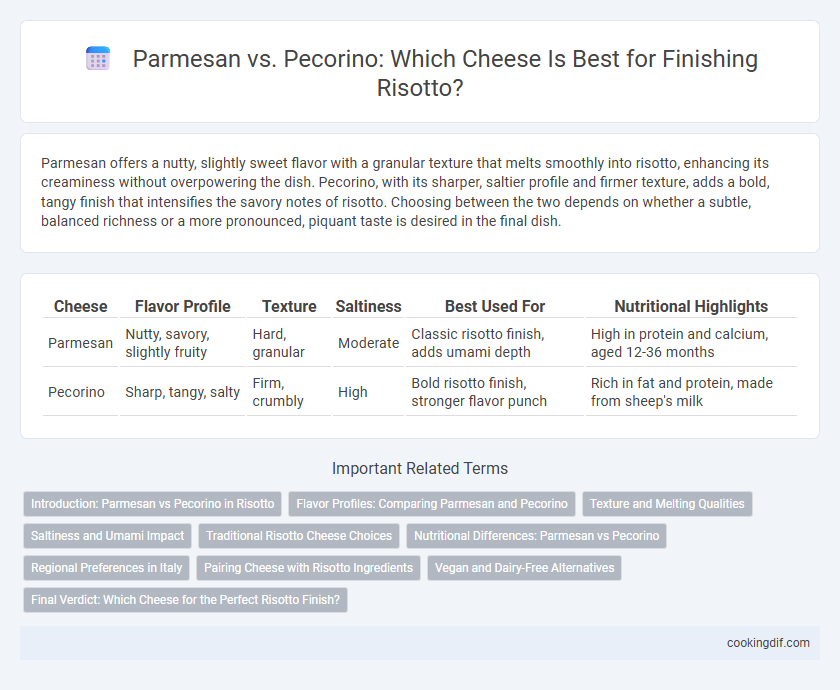Parmesan offers a nutty, slightly sweet flavor with a granular texture that melts smoothly into risotto, enhancing its creaminess without overpowering the dish. Pecorino, with its sharper, saltier profile and firmer texture, adds a bold, tangy finish that intensifies the savory notes of risotto. Choosing between the two depends on whether a subtle, balanced richness or a more pronounced, piquant taste is desired in the final dish.
Table of Comparison
| Cheese | Flavor Profile | Texture | Saltiness | Best Used For | Nutritional Highlights |
|---|---|---|---|---|---|
| Parmesan | Nutty, savory, slightly fruity | Hard, granular | Moderate | Classic risotto finish, adds umami depth | High in protein and calcium, aged 12-36 months |
| Pecorino | Sharp, tangy, salty | Firm, crumbly | High | Bold risotto finish, stronger flavor punch | Rich in fat and protein, made from sheep's milk |
Introduction: Parmesan vs Pecorino in Risotto
Parmesan and Pecorino offer distinct flavors for finishing risotto, with Parmesan providing a nutty, creamy richness that enhances the dish's smooth texture. Pecorino, made from sheep's milk, delivers a sharper and saltier profile, adding a bold depth to the risotto's delicate base. Choosing between these cheeses depends on the desired intensity and balance of savory notes in the final presentation.
Flavor Profiles: Comparing Parmesan and Pecorino
Parmesan offers a nutty, savory flavor with subtle fruity undertones, enhancing risotto with a delicate and balanced richness. Pecorino delivers a sharper, saltier, and more robust taste, adding boldness and complexity to the dish. Choosing between Parmesan and Pecorino affects risotto's final flavor, with Parmesan providing a milder finish and Pecorino imparting a distinctive, tangy punch.
Texture and Melting Qualities
Parmesan offers a granular texture and melts smoothly into risotto, creating a creamy consistency that enhances the dish's silkiness. Pecorino, with its firmer, crumbly texture, melts less uniformly but adds a sharper, tangier flavor profile. Choosing Parmesan results in a more cohesive, velvety finish, while Pecorino imparts pronounced flavor with a slightly grainier mouthfeel.
Saltiness and Umami Impact
Parmesan cheese enhances risotto with a balanced saltiness and a deep umami richness, creating a savory depth that complements the creamy texture. Pecorino, often saltier and more pungent, delivers a sharper, tangier flavor profile that intensifies the dish's overall zest. Choosing between Parmesan and Pecorino depends on desired salt levels and umami intensity, with Parmesan offering a subtle finish and Pecorino providing a bold, robust kick.
Traditional Risotto Cheese Choices
Traditional risotto cheese choices prominently feature Parmesan and Pecorino, each contributing distinct flavors and textures. Parmesan offers a nutty, savory richness with a granular texture that melts smoothly into the creamy risotto, enhancing its depth without overpowering. Pecorino, made from sheep's milk, delivers a sharper, saltier taste, creating a bolder finish that complements heartier risotto recipes with robust ingredients like wild mushrooms or sausage.
Nutritional Differences: Parmesan vs Pecorino
Parmesan contains higher protein content and essential amino acids, supporting muscle repair and overall health, while Pecorino provides more fat and calcium, beneficial for bone strength. Parmesan is lower in sodium compared to Pecorino, making it a better option for sodium-sensitive diets. Pecorino's richer fat profile contributes to a creamier texture in risotto, enhancing flavor but increasing calorie density.
Regional Preferences in Italy
In Italy, Parmesan (Parmigiano-Reggiano) is traditionally favored in Northern regions such as Emilia-Romagna for finishing risotto, valued for its nutty and savory profile that complements the creamy texture. Pecorino Romano, made from sheep's milk, is more popular in Central regions like Lazio, offering a sharper, saltier flavor that enhances risottos with robust and rustic ingredients. These regional preferences reflect Italy's diverse culinary heritage and influence the choice of cheese to achieve authentic risotto finishes.
Pairing Cheese with Risotto Ingredients
Parmesan offers a nutty, mellow flavor that pairs exceptionally well with creamy mushroom or pumpkin risotto, enhancing the dish without overpowering delicate ingredients. Pecorino, with its sharper, saltier profile, complements robust risottos featuring sausage, lentils, or spicy radicchio, adding a bold contrast that balances richness. Choosing Parmesan or Pecorino depends on the risotto's primary ingredients and desired flavor intensity, ensuring a harmonious finish that elevates the overall taste experience.
Vegan and Dairy-Free Alternatives
Parmesan and Pecorino cheeses traditionally enhance risotto with rich, savory depth but pose challenges for vegan and dairy-free diets due to their dairy content. Nutritional yeast, cashew-based cheese, and fermented tofu provide plant-based umami alternatives that replicate the sharpness and creaminess of these cheeses without animal products. Choosing these dairy-free options not only caters to dietary restrictions but also maintains the authentic flavor profile essential for a satisfying risotto finish.
Final Verdict: Which Cheese for the Perfect Risotto Finish?
Parmesan delivers a creamy, nutty richness that melds seamlessly into Risotto, enhancing its subtle flavors with a smooth, savory finish. Pecorino adds a sharper, tangier bite, imparting a bold and slightly salty contrast that elevates each spoonful with depth and complexity. For a balanced and classic Risotto finish, Parmesan remains the preferred choice, while Pecorino suits those seeking a more intense, distinctive cheese profile.
Parmesan vs Pecorino for cheese finish Infographic

 cookingdif.com
cookingdif.com